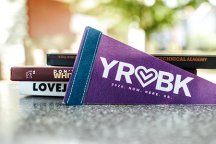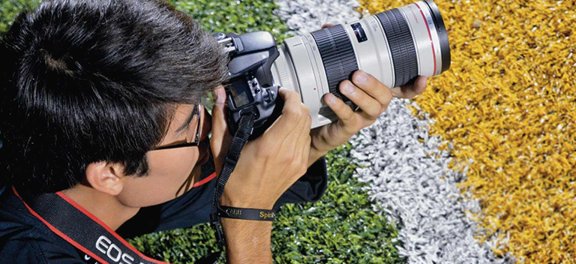Five years ago, Pinckney Community High School Photography teacher Diane Harris asked herself some questions about her teaching methods – how can I enrich my photos class? How can I give the kids more? The answer: A Night Photo Workshop, hosted in collaboration with yearbook.
“The students ask me for settings, but I am not there. So I hold one Night Workshop per semester,” Mrs. Harris said. The workshop includes a meet-up at a park, which allows them to capture movement, storytelling photos and different lighting situations.
Through the Night Photo Workshop, Mrs. Harris discovers students who want more from photography. When these students ask Mrs. Harris what they should do when the semester ends, she encourages them to join the high school’s yearbook staff to further develop and hone their skills.
“When I see kids who really have passion and can tell a story with their photos, I have a conversation with them and suggest yearbook,” Mrs. Harris said.
When photography teachers like Mrs. Harris collaborate with their school’s yearbook adviser, both programs thrive. 76% of the 2018-19 Pinckney High School (PHS) Yearbook Staff enrolled in at least one photography course with Mrs. Harris. The partnership between the yearbook adviser and photography teacher has long been established at PHS. Ten years ago when Mrs. Harris began teaching at the high school, she worked with the yearbook adviser and students during her prep hour teaching them how to set up their cameras and how to select quality photographs. Through this experience, Mrs. Harris became a yearbook advocate.
"When a cross-section of the yearbook staff has already experienced the rigors of photographing, selecting and telling the story of an event, the role of the advisor shifts from teaching students how to use a camera to assisting students in content, coverage and design."
In a new age of photo-focused consumers, quality photography is more important than ever when enticing students to purchase a yearbook. Students who join the yearbook staff after completing Mrs. Harris’ course not only understand the basics of photography, they understand trial and error and the volume of photos necessary to get an ideal shot. Mrs. Harris regularly shares her photo sessions with her students. She displays session photos and proceeds to critique them one by one, explaining how she decodes and sorts them. Through this modeling, students learn the difference between an okay photo and a great photo.
“You have to take photos. You have to share your knowledge including mistakes,” Mrs. Harris said.
The notorious 100 Pictures of a Still Object is a grueling assignment that forces students to be creative with composition. This assignment provides those who transition from photography to yearbook with a new perspective on making the ordinary extraordinary. All too often yearbook staff default to an average image, like a student standing by a locker, but photo students use unique angles and find alternate backgrounds to make their photos more interesting thus drawing the eye into the attached story about a classmate or group.
Mrs. Harris also requires each student to select and photograph an event. It could be a wedding, a soccer game or something mundane like brushing your teeth. However, their images must tell a story and be shot from a variety of angles. This photography assignment prepares students for fast paced, deadline-driven yearbook coverage. When a cross section of the yearbook staff has already experienced the rigors of photographing, selecting and telling the story of an event, the role of the advisor shifts from teaching students how to use a camera to assisting students in content, coverage and design.
The skills and confidence students attain in Mrs. Harris’ class result in their ability to produce unique yearbook layouts that require advanced photography and photoshop know-how to complete. Senior photography student and yearbook staff member Alex Daniels designed a page that merged images of high school students with famous individuals. Yearbook provides students like Alex with the opportunity to apply the techniques they learned in photography to create an original design that highlights their skills while simultaneously documenting the student body.
“I just wanted to do something different for my yearbook page, but I didn’t know how to make it happen. Mrs. Harris allowed me to share my idea and then she helped me complete my vision,” Alex Daniels said.
Mrs. Harris is the number one fan of the PHS Yearbook. She shares lenses, refreshes students on settings and encourages students to use the skills they learned in her class to capture moments and emotions that will make the yearbook memorable. As a result of her efforts, the adviser and staff are able to focus on more creative aspects like student designed layouts, theme development and storytelling instead of teaching basic photography the first few months of school. Additionally, student veterans of the photography program encourage their fellow staffers to take Mrs. Harris’ courses to learn more about photography. They apply her trial and error approach while teaching their less photo savvy staffers how to take better photographs. Leveraging students with a comprehensive understanding of photography leads to better photos. And better photos make a better yearbook.
Written by:
Kathleen Krill
Pinckney High School [MI]
Kathleen Krill has taught at Pinckney (PHS) since 2001. She currently advisers the Yearbook and PHS Connected staff and became a Certified Journalism Educator at the 2017 fall national convention.
Keeping the commitment strong
What goals can you create for the rest of this school year?
Creating a set of New Year’s resolutions seems to be a right of passage at the beginning of each new year. The challenge, as many studies confirm, is keeping the commitment strong throughout the spring. As yearbookers, we have a unique opportunity to create goals that are truly achievable, since these resolutions can affect the success of our current publication season.

Photography
How can you improve your photography? Do you notice a certain technique that all of your photos follow. Think about (simple) ways to improve the techniques, style and the process that surround your photos.
Leadership
Think about the way that you are leading the team. Consider how you provide feedback to their work. Are there ways that you can improve? Are they working as a team? Consider team building activities you can lead your staff through. Take a look at the article Creating Your Best Team for some ideas.
Design
It’s never too late (or too early) to think about design, especially for the book that comes after this one. What have you learned from your current publication that you would like to change, keep or think through for next year?
Writing
I find myself always making this goal for myself. We become better writers by writing more. Look at examples in newspapers and magazines. Also look at captions and stories you’ve already written and think about ways you could improve them. A wise teacher once taught me that “there is never a final draft.”
Coverage
We can never overthink coverage. Take a look at your coverage report and find students who do not appear much within your book, especially those under 3x coverage. How might you improve their coverage in your book? What extended coverage might you be able to implement this spring?
Yourself
Change, above all, comes from within. How can we change our attitude, perspective or overall effort on staff? Reciting to yourself that “today, I am going to capture the best of our school’s memories” can make all the difference.
Written by:
Jason Kaiser
Associate Marketing Manager, Jostens
Jason works with various print, digital and social initiatives bringing content to life through Yearbook Love, the Digital Classroom and more. A former yearbook adviser, Jason has worked with scholastic journalism for more than eight years.


